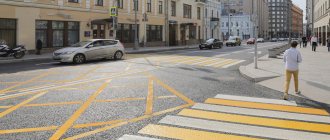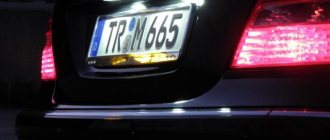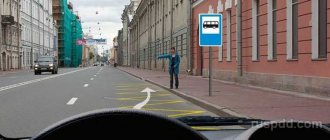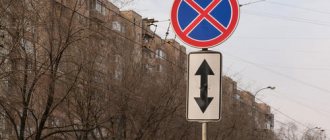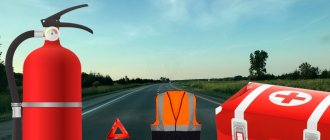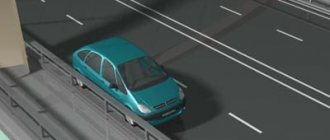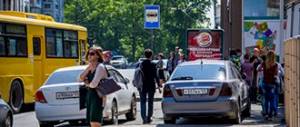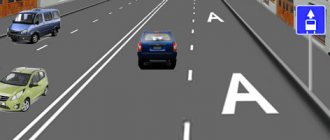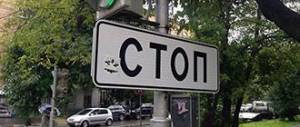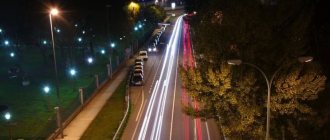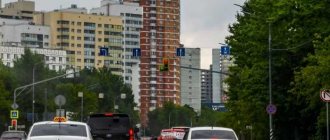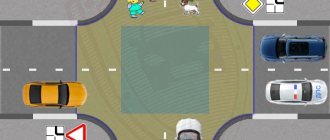General characteristics
In the simplest case, the nearest public transport stop is indicated by a corresponding sign. For example, for bus points this is the sign. 5.16. As a rule, public transport stops in the city are equipped with a rain canopy. There is almost always a sign with a traffic schedule in the pavilion. In some cases, ticket sales points are installed at the polling stations. In large cities, there is outdoor advertising at bus stops. Within the zone associated with the site, markings are placed prohibiting motorists from parking.
Is it possible for other vehicles to stop at the bus stop?
The answer to this question is contained in the traffic rules. According to the rules, stopping is not allowed closer than 15 m from the area equipped for route vehicles, marked with markings 1.17. In the absence of the latter, the distance is calculated from the location indicator. According to the meaning of the rule, the prohibition applies in all directions. For example, on a two-lane road, parking on the opposite side is not allowed, since the distance will be less than 15 m. Many drivers are interested in whether it is possible to stop at a bus stop in front of public transport. This action is also prohibited by the rules. Short-term parking is not allowed either before or after public transport in places specially equipped for it. However, there is still an exception to the rule. You can stop at a bus stop to drop off/pick up passengers. At the same time, there should be no interference with public transport.
Requirements for points on roads of category I a
The public transport stop must be located outside the roadbed. It is allowed to install both separate and combined entrances and exits to the main road. When installing them, it is necessary to be guided by the construction standards provided for junctions and intersections of highways. Stops must be located at a distance of at least 3 km. At highway intersections at various levels, to ensure ease of transfers and safety, passenger pick-up/drop-off points are located in a sector located next to pedestrian flow paths.
Landing pad
Its width must be at least 3 m. It is used for disembarking/embarking passengers on transport. The length of this section must be no less than that of the stopping area. The size of the latter is determined in accordance with the dimensions of the vehicles simultaneously located on it, but not less than 13 m. The landing area must be raised above the surface of the stopping area by 0.2 m. A curb is installed along the border of these areas. It continues along the transitional express lanes if there is a sidewalk running next to them.
Rules for sections on roads of categories I b – III
The public transport stop must be located on straight ground. It is allowed to establish a point on a curved section, with a radius of at least 1 thousand m for roads I b - II category, 600 m - III and 400 - IV category. The longitudinal slope at the stopping point should not be more than 40%. In the passenger pick-up/drop-off area, it is necessary to ensure visibility distance for car parking. Stops are shifted in the direction of traffic by at least 30 m between the nearest pavilion partitions. At junctions and intersections of roads, drop-off/pick-up points are located at a distance equal to or greater than that provided to ensure visibility of car parking. It is allowed to place stops for vehicles moving in the opposite direction before or after the junction/intersection. At the same time, they shift along the course of their movement by at least 30 m between adjacent walls of the pavilions. In general, stops are located every 3 km. In densely populated or resort areas, the distance between points is reduced to 400 m.
Bus stops: GOST
There are certain requirements for drop-off/pick-up points for public transport passengers. They relate to the immediate internal and external arrangement of sites, as well as the distance that must be maintained in such places. Bus stops in the city include:
- Waiting area (for roads 1-3 categories).
- Drive-in pocket. It is arranged when the object is located in the area of adjacent or intersection of roads.
- Stopping area.
- Transitional express lanes.
- Landing pad.
- Dividing strip (for roads 1-3 categories).
- Benches.
- Auto pavilion.
- Pedestrian paths and sidewalks (for roads 1-3 categories).
- Container and (or) trash can.
- Lighting.
- Crosswalk.
- Technical elements of traffic management (markings, fences, “Bus stop” sign, etc.).
Classification
A public transport stop can be:
- Constant. The vehicle arrives according to a schedule, usually at certain time intervals.
- On demand. The vehicle stops at the request of the passenger. A citizen who needs to leave can press a special button or say his desire out loud. A person who is waiting for transport to arrive at a stop raises his hand, signaling that he needs to get into the vehicle.
Stops on demand, as a rule, are not indicated by special signs. In some regions, however, such points differ from the usual ones. For example, in Moscow, the name of the stopping area is underlined upon request or there is a corresponding indication next to the name. Travel from such a point may be set outside the stipulated tariff.
Detour through a continuous road
According to the rules, public transport is not considered an obstacle. However, in many cases the bus stop is located on a two-lane road with a continuous line. In such situations, public transport creates an obstacle for drivers of other vehicles. When making a detour in this case, the last ones will have to cross a continuous road. And this, in turn, is a violation of the rules. As a result, the driver of another vehicle may be punished under Part 3 of Art. 12.15 Code of Administrative Offences. The sanction under this part of the article is an administrative fine of 1-1.5 thousand rubles.
Additionally
Semi-permanent stops are currently being installed. Vehicles arrive at such points at fixed time intervals. At the same time, at such stops, passenger traffic is distributed unevenly. Such pick-up/drop-off areas are located outside populated areas to ensure safety or are introduced on specialized routes. If the driver does not see anyone willing to get into the vehicle at the stop or none of the passengers wants to get out, then he will not stop. Lately, fake items have become common. They settle down near nursing homes and hospitals. Such stops help quickly identify patients suffering from short-term memory loss or other pathologies who have left the facility without permission.
Parts 4 and 5 art. 12.15 Code of Administrative Offenses
If stopped public transport is not an obstacle, then the driver of another vehicle may be charged with overtaking. In this case, liability arises under Parts 4 and 5 of Art. 12.15 Code of Administrative Offences. They establish sanctions for violating the rules for positioning a vehicle on the roadway, overtaking and oncoming traffic:
- Part 4. It says that entering, in violation of the Rules, into a lane intended for oncoming traffic, or onto a tram track in the opposite direction, except for the cases established in Part 3 of the article in question, entails an administrative penalty in the form of a fine. Its value is 5 thousand rubles. Another sanction provided for in Part 4 may be applied to the driver - deprivation of the right to drive a vehicle for 4-6 months.
- Part 5 establishes punishment for repeated administrative violations provided for in Part 4. In this case, the driver faces deprivation of his right to drive for a year. When a violation is recorded by an automatic special technical device that has video recording, photo and filming functions, a fine is provided as a sanction. Its value is similar to that established in parts 4 - 5 thousand rubles.
Traffic rules when boarding and disembarking passengers at a stop
The rules state that boarding and disembarking passengers at a public stop is permitted and is carried out after a complete stop of transport from the side of the road or sidewalk, provided that it does not interfere with other vehicles.
And it is not recommended in places where it is prohibited to do this; in this regard, there is an article subject to a fine from a small amount to an impressive amount.
Here are some prohibited places:
- where the prohibition sign hangs;
- when tram travel is restricted on its tracks;
- railway track;
- in the tunnel;
- no more than 15 meters before and after a pedestrian crossing, intersection;
- in narrow areas;
- in the bike lane.
It is necessary to know and adhere to traffic rules.
Fines for violation
If for some reason the driver had to stop at the site designated as a stop, then the possible actions of the traffic police officer who detected the violation:
- issuing a fine, the amount may fluctuate,
- or to evacuate the vehicle that violated the rules.
The driver's obligation will include payment for transportation and security in the parking lot of the seized vehicle. The best option would be for the car owner to independently eliminate the obstacles created by his vehicle.
Also, a fine may be imposed for reasons of incorrect parking:
- which creates interference,
- parking in front of a pedestrian crossing,
- in places reserved for disabled people,
- when parking second row,
- on playgrounds,
- on the lawn,
- sidewalk.
In order not to find yourself violating the rules and not having to pay fines, tow truck services and impound parking, you should try to park at bus stops for a few minutes and for good reasons, without creating any difficulties for the movement of public transport.
When disembarking or picking up passengers, it is better to park before or after the bus stop within fifteen meters.
Important point
In the case discussed above, there is actually no contradiction between the marking and the sign. This is because the solid line itself does not prohibit stopping. It is not allowed by clause 12.4 of the traffic rules. Thus, a contradiction arises between the paragraph of the Rules and the road sign. This case is not described in the traffic rules and is considered an insoluble contradiction. Accordingly, in this case Art. 1.5, according to which irremovable doubts are interpreted in favor of the person held accountable. Thus, it is impossible to attract the driver under Part 4 or 5 of Art. 12.15 Code of Administrative Offences.
Conversation with the inspector in case of violation
The reason for the absence of a road sign may be several factors:
- Having opened a new stop, the installation of the sign was postponed for a while,
- The previously installed sign was damaged, it was removed, and a new one was not installed.
But no matter how the reason influences the absence of a sign, the driver who violated the rules, with a sense of tact, in an unobtrusive form, can try to assure the traffic police inspector of his innocence. And then the likelihood of avoiding a fine will increase.
Fine for parking at a bus stop
A violation of traffic rules is stopping at a distance of less than fifteen meters from the space indicated by signs . If the stop is occupied by cars, it will be extremely difficult for the MTS driver to stop in the right place. Passengers will not be able to exit the bus/tram as required by regulations. As a result, safety decreases and the risk of accidents increases significantly.
In addition, attention should be paid to marking No. 1.17. According to traffic regulations, marking No. 1.17 indicates a prohibition on turning around in the stopping area of route vehicles.
Marking No. 1.17
The rules, of course, provide for punishment and liability for non-compliance with the regulations. A driver who ignored stop signs for a route vehicle faces a fine of 1,000 rubles and a warning. For two capitals - Moscow and St. Petersburg, the fine is up to 3,000 rubles. Traffic police officers also have the right to temporarily detain the violator’s car.
Video: Traffic rules, pedestrian crossings and stopping places for route vehicles
